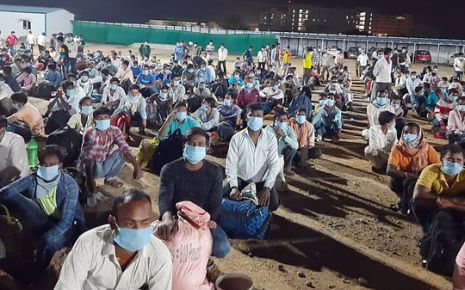Fixation and Revision of Minimum Wages
The fixation and revision of minimum wages is an important aspect of labour and
employment regulations in many countries. Minimum wage laws are designed to
establish a baseline level of compensation that employers must pay to workers
for their labour. The purpose of these laws is to protect workers from
exploitation, ensure fair compensation, and provide a decent standard of living.
The process of fixing and revising minimum wages typically involves a combination of legislative action, government agencies, and consultation with stakeholders such as trade unions, employers' associations, and worker representatives. The specific procedures and institutions involved can vary from country to country. The concept of minimum wages in India was brought in the year 1920 by Mr. K.G.R Chaudhary, who proposed the bill to formulate the policy of minimum wages at the International Labour Conference.
The bill was brought in 1946, and by 1948, the bill of Minimum Wages Act was enforced to save the rights of the workers. The provisions of the Act are intended to achieve the objective of doing social justice to workers employed in the scheduled employment by prescribing the minimum rate of wages for them. In other words, the Act aims to provide a statutory fixation of minimum wages with a view to preventing the exploitation of labor.
It's important to note that the specific processes and mechanisms for fixing and revising minimum wages can vary significantly across different countries and jurisdictions. The above overview provides a general framework, but the actual procedures and practices may differ depending on the legal, economic, and political context of each country.
Objectives Of The Act
It's important to note that the objectives of the Minimum Wages Act may be influenced by the specific social, economic, and political context of each country or jurisdiction. The Act's effectiveness in achieving these objectives can depend on factors such as enforcement mechanisms, compliance rates, and the level of cooperation among various stakeholders, including employers, workers, and government authorities.
The basic wages and house rent allowance may vary with the cost of living index.
The basic rate of wages with or without house rent allowance based on the cost of living index number of the employee
All-inclusive rates for the basic rate of wages with the cost of living allowances and cash value of concessional supply of materials
The term minimum wages has not been defined under the provision of the Minimum Wages Act, 1948 presumably because it would not be possible to lay down a uniform minimum wage for all industries throughout the country on account of different and varying conditions prevailing from one industry to another.
Scheduled Employments:
The Act categorizes specific employments into schedules based on the nature of work, industry, and geographic region. Each schedule includes different occupations or industries for which minimum wages need to be fixed. The number and nature of scheduled employment may vary from state to state.
As far as section 5 of the Minimum Wages Act is concerned, there are two modes of procedures for fixing and revising the minimum wages. One common thing among both of the procedures is to empower the Government in reaching a favorable result regarding the fixation of minimum wage.
The two modes of fixing and revising minimum wages can be categorized as follows:
Committee Method
Under the Minimum Wages Act, of 1948 in India, the committee method is a mechanism used for the fixation and revision of minimum wages for certain scheduled employments. The committee method involves the establishment of committees that play a crucial role in conducting inquiries, examining relevant factors, and making recommendations for the fixation and revision of minimum wages.
Here's an overview of the committee method under the Minimum Wages Act:
The committee method ensures a consultative and evidence-based approach to the fixation and revision of minimum wages, incorporating the perspectives of various stakeholders and considering factors specific to the scheduled employment. It helps in establishing fair and reasonable minimum wages that balance the interests of workers and employers while promoting social justice and economic well-being.
Notification Method
Under the Minimum Wages Act, of 1948 in India, the notification method is used for the fixation and implementation of minimum wages for various scheduled employments. The notification method involves the issuance of an official notification by the appropriate government specifying the minimum rates of wages applicable to the scheduled employment.
Here's an overview of the notification method under the Minimum Wages Act:
The notification method provides a legally binding mechanism for the fixation and implementation of minimum wages. It ensures that employers are aware of their obligations and workers are entitled to receive the prescribed minimum wages for their labour. The method allows for transparency and uniformity in wage determination across scheduled employment while facilitating compliance and enforcement.
Penalties
As per section 22 of the Minimum Wages Act, the penalties may be charged in the case if:
In conclusion, the fixation of minimum wages is a critical aspect of labour legislation aimed at ensuring fair remuneration, preventing exploitation, reducing income inequality, promoting social justice, stimulating consumer demand, providing social protection, and upholding labour standards. Minimum wage laws exist in various countries, including India, and are enacted through specific acts like the Minimum Wages Act, of 1948.
The process of fixing minimum wages involves research and data analysis, consultation with stakeholders, consideration of various factors such as the cost of living and productivity, and the establishment of a minimum wage floor. Governments may utilize methods such as committee-based approaches, where committees conduct inquiries, analyze data, and make recommendations for wage fixation. Alternatively, the notification method may be used, whereby the government issues an official notification specifying the minimum wage rates applicable to scheduled employment.
Overall, the fixation and implementation of minimum wages aim to create a fair and just labour environment, protect workers from exploitation, and contribute to social and economic well-being. By providing a decent standard of living for workers, minimum wage laws play a crucial role in promoting equality, safeguarding workers' rights, and supporting sustainable economic growth.
References:
The process of fixing and revising minimum wages typically involves a combination of legislative action, government agencies, and consultation with stakeholders such as trade unions, employers' associations, and worker representatives. The specific procedures and institutions involved can vary from country to country. The concept of minimum wages in India was brought in the year 1920 by Mr. K.G.R Chaudhary, who proposed the bill to formulate the policy of minimum wages at the International Labour Conference.
The bill was brought in 1946, and by 1948, the bill of Minimum Wages Act was enforced to save the rights of the workers. The provisions of the Act are intended to achieve the objective of doing social justice to workers employed in the scheduled employment by prescribing the minimum rate of wages for them. In other words, the Act aims to provide a statutory fixation of minimum wages with a view to preventing the exploitation of labor.
It's important to note that the specific processes and mechanisms for fixing and revising minimum wages can vary significantly across different countries and jurisdictions. The above overview provides a general framework, but the actual procedures and practices may differ depending on the legal, economic, and political context of each country.
Objectives Of The Act
- Ensuring Fair Remuneration:
One of the primary objectives of the Minimum Wages Act is to ensure that workers receive fair remuneration for their labour. It aims to establish a minimum wage level that provides workers with a decent standard of living, taking into account factors such as the cost of living, inflation, and economic conditions.
- Preventing Exploitation:
The Act seeks to protect vulnerable workers from exploitation by setting a floor on wages. It aims to prevent the payment of unreasonably low wages that can lead to unfair labour practices, including forced labour, sweatshop conditions, and abusive employment relationships.
- Reducing Income Inequality:
Minimum wage laws are often seen as a tool to address income inequality by providing a basic level of income for workers. By establishing a minimum wage, the Act aims to reduce wage disparities and ensure that workers at the lower end of the income scale receive a fair share of the economic gains.
- Promoting Social Justice:
The Minimum Wages Act is rooted in principles of social justice and aims to create a more equitable society. It recognizes that workers deserve a living wage that enables them to meet their basic needs, support their families, and participate in society.
- Stimulating Consumer Demand:
Another objective of the Act is to stimulate consumer demand and support economic growth. By ensuring that workers have sufficient income to meet their basic needs, it can contribute to increased consumer spending, which in turn can drive economic activity and boost businesses.
- Providing Social Protection:
The Act serves as a social protection mechanism by establishing a minimum wage floor. It helps safeguard workers from extreme poverty and provides a safety net for those in low-paid jobs. By ensuring a minimum level of income, it can contribute to poverty reduction and social welfare.
- Promoting Labour Standards:
Minimum wage laws often go hand in hand with other labour standards, such as regulations related to working hours, overtime pay, and workplace safety. The Act aims to promote and enforce these labour standards, ensuring that workers are protected and their rights are upheld.
It's important to note that the objectives of the Minimum Wages Act may be influenced by the specific social, economic, and political context of each country or jurisdiction. The Act's effectiveness in achieving these objectives can depend on factors such as enforcement mechanisms, compliance rates, and the level of cooperation among various stakeholders, including employers, workers, and government authorities.
Minimum Rate Of Wages Under The Act
Under section 3 of the Minimum Wages Act, the minimum rate of wages fixed by the Appropriate Government in respect of the scheduled employment consists of the following:The basic wages and house rent allowance may vary with the cost of living index.
The basic rate of wages with or without house rent allowance based on the cost of living index number of the employee
All-inclusive rates for the basic rate of wages with the cost of living allowances and cash value of concessional supply of materials
The term minimum wages has not been defined under the provision of the Minimum Wages Act, 1948 presumably because it would not be possible to lay down a uniform minimum wage for all industries throughout the country on account of different and varying conditions prevailing from one industry to another.
Procedure For Fixation And Revision Of Minimum Wages
In India, the fixation of minimum wages is governed by the Minimum Wages Act, of 1948. The Act provides for the fixation and enforcement of minimum wages for various scheduled employments across different industries and sectors.Scheduled Employments:
The Act categorizes specific employments into schedules based on the nature of work, industry, and geographic region. Each schedule includes different occupations or industries for which minimum wages need to be fixed. The number and nature of scheduled employment may vary from state to state.
As far as section 5 of the Minimum Wages Act is concerned, there are two modes of procedures for fixing and revising the minimum wages. One common thing among both of the procedures is to empower the Government in reaching a favorable result regarding the fixation of minimum wage.
The two modes of fixing and revising minimum wages can be categorized as follows:
- Committee Method [Section 5(1)]
- Notification Method [Section 5(2)]
Committee Method
Under the Minimum Wages Act, of 1948 in India, the committee method is a mechanism used for the fixation and revision of minimum wages for certain scheduled employments. The committee method involves the establishment of committees that play a crucial role in conducting inquiries, examining relevant factors, and making recommendations for the fixation and revision of minimum wages.
Here's an overview of the committee method under the Minimum Wages Act:
- Minimum Wages Fixation Committee:
For certain scheduled employments, the appropriate government may constitute a Minimum Wages Fixation Committee. This committee is tasked with conducting inquiries and recommending the minimum wages to be fixed for the particular employment.
- Composition of the Committee:
The Minimum Wages Fixation Committee typically consists of representatives from employers, employees, independent experts, and government officials. The committee may include individuals with expertise in relevant fields such as labour economics, industrial relations, or specific industries covered by the scheduled employment.
- Inquiries and Data Collection:
The committee conducts detailed inquiries and collects relevant data to inform the process of fixing minimum wages. This may include studying factors such as the cost of living, standard working hours, prevailing wage rates in similar employments, skill requirements, and the capacity of employers to pay.
- Examination of Factors:
The committee examines various factors that influence wage determination, considering both economic and social aspects. These factors may include living conditions, social needs, productivity levels, regional variations, and the impact of proposed wage rates on workers and employers.
- Stakeholder Consultation:
The committee may engage in consultations with stakeholders such as employers' associations, trade unions, worker representatives, and other interested parties. These consultations provide an opportunity for stakeholders to present their views, concerns, and suggestions regarding the fixation and revision of minimum wages.
- Recommendations and Reports:
Based on the inquiries, data analysis, and stakeholder consultations, the committee prepares a report containing its recommendations for the fixation or revision of minimum wages. The report may outline the proposed wage rates, the rationale behind the recommendations, and any additional provisions or considerations relevant to the scheduled employment.
- Government Decision:
The government reviews the recommendations made by the Minimum Wages Fixation Committee and takes a decision on the fixation or revision of minimum wages. The government considers the committee's report along with other relevant factors, such as economic conditions, legal requirements, and administrative feasibility.
- Notification and Implementation:
Once the government approves the minimum wages based on the committee's recommendations, it issues a notification specifying the minimum rates of wages applicable to the scheduled employment. This notification provides the legal basis for employers to comply with the prescribed minimum wages, and it includes details such as the effective date and any other relevant provisions.
The committee method ensures a consultative and evidence-based approach to the fixation and revision of minimum wages, incorporating the perspectives of various stakeholders and considering factors specific to the scheduled employment. It helps in establishing fair and reasonable minimum wages that balance the interests of workers and employers while promoting social justice and economic well-being.
Notification Method
Under the Minimum Wages Act, of 1948 in India, the notification method is used for the fixation and implementation of minimum wages for various scheduled employments. The notification method involves the issuance of an official notification by the appropriate government specifying the minimum rates of wages applicable to the scheduled employment.
Here's an overview of the notification method under the Minimum Wages Act:
- Identification of Scheduled Employments:
The Act categorizes specific employments into schedules based on the nature of work, industry, and geographic region. Each schedule includes different occupations or industries for which minimum wages need to be fixed. The number and nature of scheduled employment may vary from state to state.
- Consultation and Advisory Boards:
Before fixing the minimum wages, the appropriate government may consult with advisory boards or committees established under the Act. These boards consist of representatives from employers, employees, independent experts, and government officials. Their input may be considered in determining the minimum wages for the scheduled employments.
- Determination of Minimum Wages:
The appropriate government, either the central or state government, examines relevant factors such as the cost of living, prevailing wage rates, standard working hours, skill requirements, and the capacity of employers to pay. Based on these considerations, the government determines the minimum rates of wages for each scheduled employment.
- Preparation of Notification:
Once the minimum wages are determined, the government prepares an official notification. The notification specifies the minimum rates of wages applicable to each scheduled employment. It includes details such as the effective date, the period of applicability, wage components (basic wages, dearness allowance, etc.), and any other relevant provisions.
- Publication and Legal Effect:
The notification containing the minimum wages is published in the official gazette or other appropriate publications as required by law. Once published, the notification carries the force of law, and employers in the scheduled employments are legally obligated to pay their workers at least the prescribed minimum wages.
- Compliance and Enforcement:
The government designates labour inspectors or enforcement officers who are responsible for ensuring compliance with the minimum wages specified in the notification. These officials conduct inspections, receive complaints, and take appropriate action against employers who fail to pay the mandated minimum wages. Non-compliance may result in penalties or other legal consequences for employers.
- Periodic Revision and Amendments:
The government periodically reviews the minimum wages and may make necessary revisions or amendments based on changing economic conditions, cost of living, and other relevant factors. The revised minimum wages are communicated through subsequent notifications, which supersede the previous ones.
The notification method provides a legally binding mechanism for the fixation and implementation of minimum wages. It ensures that employers are aware of their obligations and workers are entitled to receive the prescribed minimum wages for their labour. The method allows for transparency and uniformity in wage determination across scheduled employment while facilitating compliance and enforcement.
Penalties
As per section 22 of the Minimum Wages Act, the penalties may be charged in the case if:
- The employees pay less than the minimum wages prescribed by the Act
- The employer does not comply with the provisions given in section 13 of the Act
- Fine: extending upto 500 rupees
- Imprisonment: 6 months
In conclusion, the fixation of minimum wages is a critical aspect of labour legislation aimed at ensuring fair remuneration, preventing exploitation, reducing income inequality, promoting social justice, stimulating consumer demand, providing social protection, and upholding labour standards. Minimum wage laws exist in various countries, including India, and are enacted through specific acts like the Minimum Wages Act, of 1948.
The process of fixing minimum wages involves research and data analysis, consultation with stakeholders, consideration of various factors such as the cost of living and productivity, and the establishment of a minimum wage floor. Governments may utilize methods such as committee-based approaches, where committees conduct inquiries, analyze data, and make recommendations for wage fixation. Alternatively, the notification method may be used, whereby the government issues an official notification specifying the minimum wage rates applicable to scheduled employment.
Overall, the fixation and implementation of minimum wages aim to create a fair and just labour environment, protect workers from exploitation, and contribute to social and economic well-being. By providing a decent standard of living for workers, minimum wage laws play a crucial role in promoting equality, safeguarding workers' rights, and supporting sustainable economic growth.
References:
- https://www.toppr.com/guides/fundamentals-of-laws-and-ethics/minimum-wages-act/procedure-for-fixing-and-revising-minimum-wage/
- https://www.deskera.com/blog/minimum-wages-act/
- https://clc.gov.in/clc/sites/default/files/MinimumWagesact.pdf
- https://labour.gov.in/sites/default/files/wage_cell.pdf
- https://pib.gov.in/PressReleaseIframePage.aspx?PRID=1909994
Award Winning Article Is Written By: Mr.Sanskar Pradhan
Authentication No: JL318509707905-4-0723
Law Article in India
Legal Question & Answers
Lawyers in India - Search By City
LawArticles
How To File For Mutual Divorce In Delhi

How To File For Mutual Divorce In Delhi Mutual Consent Divorce is the Simplest Way to Obtain a D...
Increased Age For Girls Marriage

It is hoped that the Prohibition of Child Marriage (Amendment) Bill, 2021, which intends to inc...
Facade of Social Media

One may very easily get absorbed in the lives of others as one scrolls through a Facebook news ...
Section 482 CrPc - Quashing Of FIR: Guid...

The Inherent power under Section 482 in The Code Of Criminal Procedure, 1973 (37th Chapter of t...
The Uniform Civil Code (UCC) in India: A...

The Uniform Civil Code (UCC) is a concept that proposes the unification of personal laws across...
Role Of Artificial Intelligence In Legal...

Artificial intelligence (AI) is revolutionizing various sectors of the economy, and the legal i...









Please Drop Your Comments